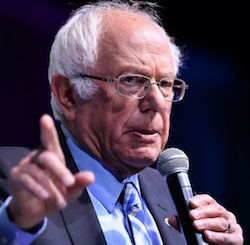
If Bernie Sanders, the left-of-center senator from Vermont, becomes the Blue candidate for president, expect political dirt like you’ve never seen. But underneath the mud and memes, behind the deepfakes and denials, we may witness a legitimate debate over the relative merits (and demerits) of supply-side and demand-side economics.
Supply-side economists believe that if you lower taxes and cut regulations, entrepreneurs will be unleashed to create new businesses, hire more workers, produce more stuff, and even generate more tax revenue for government.
Supply-siders have been in the macroeconomic saddle for the past 40 years. The word “saddle” is apt: the concept roared out of the American West. Arthur Laffer (who advised Donald Trump in 2016) was its premier economist. Journalist Jude Wanniski popularized the term “supply-side” and published a 1978 book about it. Ronald Reagan implemented it, more or less. After the “stag-flation” of the 1970s, supply-side economics blew in like a refreshing zephyr.
And many people became gloriously rich as a result. The early 1980s saw the start of the longest bull market, in both stocks and bonds, that the universe had ever seen. Though factories went dark, the deregulated financial and tech sectors flourished. The fact that tens of millions of baby-boomers were working, saving, buying homes and procreating didn’t hurt.
Wage deflation
But today, there are signs that the supply-side miracle has run its course. Boomers are retiring. Interest rates have no room left to fall. Tax cuts have added to unprecedented deficits. Homes and financial assets are priced to the max. The financial crisis showed that deregulation has a downside.
Supply-side economics brought, or coincided with, rising inequality. America gradually divided into two camps: A minority with large amounts of appreciated assets, like homes and securities, and a majority with few or no assets that appreciate. The ever-widening gap between haves and have-nots is well-documented.
As the Pew Research Center reported this month, national income is concentrated among fewer people. Eighty percent of Americans now receive only 43% of national income, down from 56% in 1968. Instead of inflation (the bane of creditors), we’ve seen wage deflation (the bane of debtors). Consumer prices have almost doubled since 1990, but wages have grown only 26.5%. We’re at full employment, but the civilian labor force participation rate is lower than it was in 2000.
This creeping poverty, linked to globalization, shows up in the falling life expectancies of rural white workers with less than college educations. Unable to earn adequate pay, many don’t marry, form families or set up households. Frustrated by their failure to meet their own and society’s expectations, they become prey to OxyContin, heroin and anger. Once proudly self-reliant, they welcome someone to blame.
The president rode to victory on that wave of anger, and on promises to reopen coal mines and steel mills. Instead, he lowered taxes and interest rates, which was good for stocks. But that hasn’t helped people whose income and taxes are already low, who pay double-digit interest rates on credit cards, and who own few if any equities.
Another turning point

Bernie Sanders
Hence the return of demand-side economics. Also known as post-Keynesian economics or the (much maligned and misunderstood) Modern Monetary Theory, demand-side economics held sway from 1932 until 1971, when Richard Nixon abandoned the gold standard. Bernie Sanders is its atavistic avatar.
Demand-side is the flip-side of supply-side. Supply-siders and other neoclassical economists believe, for instance, that a higher minimum wage will lead to higher prices, layoffs, and a slowdown. Demand-siders and other “heterodox” economists believe that higher wages will lead to higher demand, more production, and more employment. They insist that less inequality means more prosperity for everybody, even the rich.
So if you hear Sanders fulminate about universal health care or free college, think “demand-side” economics. He’s addressing the same malaise that Trump exploited, but with a bottom-up solution that’s been out of favor for more than 40 years. Supply-side economics has been so dominant for so long, in fact, that you almost have to be Bernie’s age to remember that demand-siders once ruled the field.
© 2020 RIJ Publishing LLC. All rights reserved.

